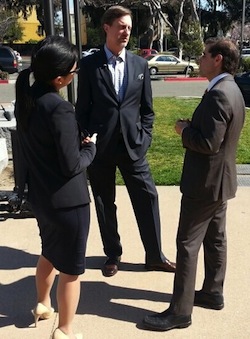
FCC Chairman Julius Genachowski sees a gigabit city in San Leandro.
Julius Genachowski, the chairman of the Federal Communications Commission (FCC) visited San Leandro today, taking a look at the economic progress kindled by the Lit San Leandro project and delivering a keynote speech to local leaders, business people, city staff and proud residents. I’ll have more on his remarks later.
I was fortunate enough to be invited as one of the opening speakers. My assignment was to give some background on efforts in the Bay Area and around California to develop our economy by developing broadband infrastructure:
Here in the Bay Area, we are surrounded by the fattest Internet pipes on the planet. We have the world’s greatest concentration of innovative, high technology – revolutionary – talent, companies and jobs.
But we’re just getting started.
Most communities in the Bay Area, most companies and people, can’t touch those fat broadband pipes yet. That’s how it was here, in San Leandro, when the Lit San Leandro project began two years ago. The main lines of the Internet run right through the middle of town. But there was no local access, no onramp here.
Businesses struggled to get any kind of Internet access, affordable or not. Upgrading broadband infrastructure in older commercial and industrial districts is not a priority for incumbent service providers.
One of those businesses was OSIsoft. They’re here today to tell their own story, so I won’t spoil it. But Pat Kennedy saw a solution and worked with the City of San Leandro to implement it. Pat and the Lit San Leandro team made it happen. The City, though, deserves a lot of credit too. The business development team recognized the opportunity and worked across departments and with the City Council to find ways to say yes to it.
That’s the key. Recognizing the opportunity and embracing it. Part of that job is making sure that everyone’s interests are acknowledged and protected. It’s also to move ahead without getting bogged down in the process and move ahead with a clear view of the benefits for all. And that’s what the City of San Leandro did.
Thanks to some far-sighted work by legislators in Sacramento – more of that gets done than commonly recognized – the California Public Utilities Commission created a network of regional broadband consortia across the state. In just a year, those community based groups, groups that pull together public agencies, educational institutions, non-profits and private companies with capital to invest, those groups have generated dozens of new broadband projects.
The East Bay Broadband Consortium is one example. I recently worked with them to assess connectivity in this region. We developed a grading system and came up with a city by city and county by county report card. Two things stood out.
First, in most communities, businesses need help to get the broadband speed and quality at the affordable prices that our centers of high tech excellence take for granted. Whether it’s finding incentives for incumbent carriers to upgrade existing facilities, or partnering with entrepreneurs to build new gigabit fiber networks, or even dipping a toe into the municipal broadband business, cities have a vital role to play and valuable resources to offer. Not the least of which is leadership. As we have here in San Leandro.
Second, the cities with the highest grades are the ones with the deepest history of competition between telecommunications service providers. Central Contra Costa County cities scored A’s and B’s because they have three carriers that compete with each other in a number of ways, including investing in new fiber optic lines, putting private capital into upgraded broadband infrastructure.
Here in Alameda County, the cities with the highest grades are Berkeley and the City of Alameda. A private company, Sonic, has invested in building competitive broadband facilities in Berkeley. In Alameda, the city took the lead, built its own system, spurred fierce competition and stepped out of the business when the time was ripe. The infrastructure that was built by the city and its competitors is still there, still serving the residents of Alameda, still providing homes and businesses with some of the best Internet service available in the East Bay.
Other cities have followed their lead. The City of Benicia is working to turn what was a major twentieth century industrial park into a twenty first century job engine by bringing in better broadband infrastructure. In Oakland, there’s an ongoing effort to bridge the divide between businesses and homes that have superior Internet access and those that don’t.
It’s no coincidence that the best and cheapest broadband access in the Bay Area is in Palo Alto and Santa Clara. As new industries – a new economy – grew, those cities built municipal fiber optic networks. As businesses have grown and created jobs, local fiber optic networks have grown to serve them. Resulting in even more business and more jobs. We’re starting to see the same here in San Leandro. And that’s just the beginning.
Chairman Genachowski, for gigabit cities, the future is right here.
